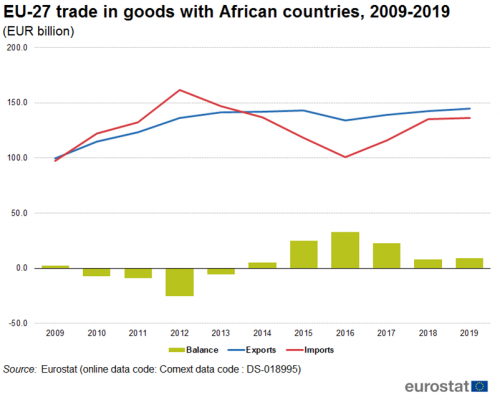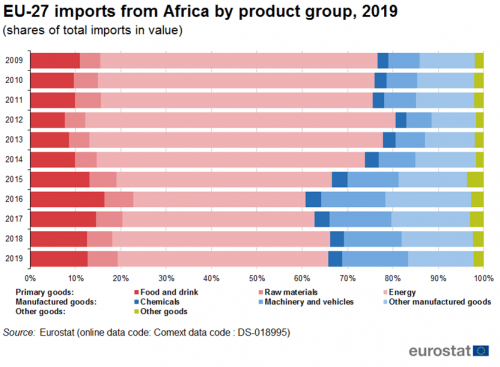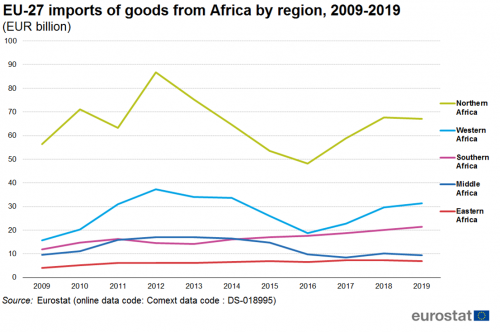Archive:Africa-EU - international trade in goods statistics
Data extracted in April 2020.
Planned article update: May 2021.
Highlights
In 2019, almost 70 % of goods exported from the EU to Africa were manufactured goods.
In 2019, over 65 % of goods imported to the EU from Africa were primary goods (food and drink, raw material and energy).
Northern Africa: largest trade in goods partner of the EU among the African regions in 2019.
EU-28, trade in goods exports, imports and balance with African countries, 2008-2018
This article provides a picture of international trade in goods between the European Union (EU) and Africa. It analyses the type of goods exchanged and the shares of each EU Member State in those exchanges. In this article the UN subdivision of Africa in five different regions is used (as shown in Map 1).
This article is part of an online publication providing recent statistics on international trade in goods, covering information on the EU's main partners, main products traded, specific characteristics of trade as well as background information.
<articlecontent>
Africa’s main trade in goods partner is the EU
The largest export and import partner for Africa is the EU-27 with 31 % of exports and 29 % of imports. In exports it was followed by other African countries (16 %) and China (11 %). For imports these two had switched places, second was China (16 %) and third were other African countries (13 %).
in 2009 EU exports to and imports from Africa were very close and the trade balance was only EUR 2.3 billion (see Figure 2). After the crisis, both imports from and exports to Africa picked up, with imports growing slightly stronger. This trend continued until 2012, when the trade deficit reached EUR 25 billion. However, afterwards imports from Africa decreased, while exports continued to grow. The year 2014 was a turning point and the deficit turned into a surplus of EUR 5.1 billion. Two years later, in 2016, the EU had a record surplus in trade in goods (EUR 33 billion). After that, growing imports from Africa saw the trade surplus decline. It was EUR 8.8 billion in 2019.

(EUR billion)
Source: Eurostat - Comext DS-018995
Manufactured goods dominate exports to Africa
In 2009, 77 % of goods exported from the EU to Africa were manufactured goods (see Figure 3). This share fell to 70 % in 2019, while the share of primary goods rose from 20 % to 28 %. The declining share of manufactured goods was mostly caused by the declining share of machinery and vehicles, from 42 % in 2009 to 36 % in 2019.

(shares of total exports in value)
Source: Eurostat - Comext DS-018995
Primary goods dominate imports with Africa
For imports from Africa, primary goods are the largest group (see Figure 4). However, between 2009 and 2019 there share decreased from 77 % to 66 % mainly due to the decreasing share of energy which is partly explained by falling oil and gas prices. In the same period, the share of manufactured goods rose from 21 % to 32 %. This was due to increasing imports of machinery and vehicles from 7 % to 15 %.

(shares of total imports in value)
Source: Eurostat - Comext DS-018995
Northern Africa largest trade in goods partner
EU exports of goods to Northern Africa rose from EUR 54 billion in 2009 to EUR 76 billion in 2019 (see Figure 5), equivalent to an average annual growth rate of 3.5 %. The growth rate was highest in Eastern Africa (5.7 %) followed by Western Africa (5.4 %) and Southern Africa (5.2 %). Exports of goods to Middle Africa (-2.3 %) declined in this period .

(EUR billion)
Source: Eurostat - Comext DS-018995
Figure 6, depicting the evolution of imports from the five African regions, shows a small decline of imports from Middle Africa betweem 2009 and 2019. Western Africa (7.1 %) had the highest growth rate, followed by Southern Africa (6.2 %) and Eastern Africa (5.4 %). Although imports from Northern Africa (1.8 %) grew less strongly, they still made up almost half of all imports from Africa.

(EUR billion)
Source: Eurostat - Comext DS-018995
In 2019, the EU had trade in goods deficits Middle Africa (EUR 2.0 billion) and Southern Africa (EUR 2.4 billion) as shown in Figure 7. In contrast, there were trade in goods surpluses with Eastern and Southern Africa (both EUR 2.4 billion) and Northern Africa (EUR 8.4 billion). The trade balance with Northern Africa has varied strongly in the past 10 years; there was a deficit of EUR 17.5 billion in 2012 and a surplus, of EUR 25.2 billion in 2016.

(EUR billion)
Source: Eurostat - Comext DS-018995
<sesection>
Spain, France, Germany, the Netherlands and Italy largest EU trade in goods partners for Africa
France (EUR 26 billion), Germany (EUR 23 billion), Spain (EUR 19 billion), the Netherlands and Italy (both EUR 17 billion) were the largest exporters of goods to Africa in 2019 (Table 1). Cyprus (25.3 %), Portugal (21.1 %) and Malta (18.6 %) had the highest shares for exports to Africa in their total exports to countries outside the EU.

(EUR million and %)
Source: Eurostat - Comext DS-018995
The five largest exporters were also the largest importers of goods from Africa in 2019 (Table 2). Spain (EUR 27 billion) led, followed by France (EUR 24 billion), Italy, Germany (both EUR 21 billion) and the Netherlands (EUR 15.9 billion). The highest shares of imports from Africa in total extra-EU imports were found in Portugal (18.8 %), Spain (17.8 %), France and Italy (both 11.7 %).

(EUR million and %)
Source: Eurostat - Comext DS-018995
In 2019, 21 EU Member States had a trade in goods surplus with Africa. The highest surplus, EUR 4 billion, was found in Belgium followed by Germany and France (both EUR 3 billioin). The six countries that had a trade in goods deficit with Africa were Croatia (EUR -86 Slovenia (EUR -149 million), Estonia (EUR -154 million), Portugal (EUR -252 million), Italy (EUR -4 billion) and Spain (EUR -8 billion).

(EUR million)
Source: Eurostat - Comext DS-018995
Source data for tables and graphs
Data sources
EU data is taken from Eurostat's COMEXT database. COMEXT is the reference database for international trade in goods. It provides access not only to both recent and historical data from the EU Member States but also to statistics of a significant number of third countries. International trade aggregated and detailed statistics disseminated via the Eurostat website are compiled from COMEXT data according to a monthly process.
Data are collected by the competent national authorities of the Member States and compiled according to a harmonised methodology established by EU regulations before transmission to Eurostat. For extra-EU trade, the statistical information is mainly provided by the traders on the basis of customs declarations.
EU data are compiled according to Community guidelines and may, therefore, differ from national data published by the Member States. Statistics on extra-EU trade are calculated as the sum of trade of each of the 28 EU Member States with countries outside the EU. In other words, the EU is considered as a single trading entity and trade flows are measured into and out of the area, but not within it.
Data from the perspective of Africa (as used in figure 1) is based on statistics from UNCTAD, combining data from UN Comtrade, IMF, Eurostat, UNCTADstat and UNCTAD secretariat calculations.
Methodology According to the EU concepts and definitions, extra-EU trade statistics (trade between EU Member States and non-EU countries) do not record exchanges involving goods in transit, placed in a customs warehouse or given temporary admission (for trade fairs, temporary exhibitions, tests, etc.). This is known as ‘special trade’. The partner is the country of final destination of the goods for exports and the country of origin for imports.
Product classification Information on commodities exported and imported is presented according to the Standard international trade classification (SITC). A full description is available from Eurostat’s classification server RAMON.
Unit of measure Trade values are expressed in millions or billions (109) of euros. They correspond to the statistical value, i.e. to the amount which would be invoiced in case of sale or purchase at the national border of the reporting country. It is called a FOB value (free on board) for exports and a CIF value (cost, insurance, freight) for imports.
Context
Trade is an important indicator of Europe’s prosperity and place in the world. The block is deeply integrated into global markets both for the products it sources and the exports it sells. The EU trade policy is an important element of the external dimension of the ‘Europe 2020 strategy for smart, sustainable and inclusive growth’ and is one of the main pillars of the EU’s relations with the rest of the world.
Because the 28 EU Member States share a single market and a single external border, they also have a single trade policy. EU Member States speak and negotiate collectively, both in the World Trade Organization, where the rules of international trade are agreed and enforced, and with individual trading partners. This common policy enables them to speak with one voice in trade negotiations, maximising their impact in such negotiations. This is even more important in a globalised world in which economies tend to cluster together in regional groups.
The openness of the EU’s trade regime has meant that the EU is the biggest player on the global trading scene and remains a good region to do business with. Thanks to the ease of modern transport and communications, it is now easier to produce, buy and sell goods around the world which gives European companies of every size the potential to trade outside Europe.
- International trade in goods (t_ext_go), see:
- International trade in goods - long-term indicators (t_ext_go_lti)
- International trade in goods - short-term indicators (t_ext_go_sti)
- International trade in goods (ext_go), see:
- International trade in goods - aggregated data (ext_go_agg)
- International trade in goods - long-term indicators (ext_go_lti)
- International trade in goods - short-term indicators (ext_go_sti)
- International trade in goods - detailed data (detail)
- EU trade since 1988 by SITC (DS-018995)
- International trade in goods statistics - background
- International trade in goods (ESMS metadata file — ext_go_agg_esms)
- User guide on European statistics on international trade in goods
- European Commission

